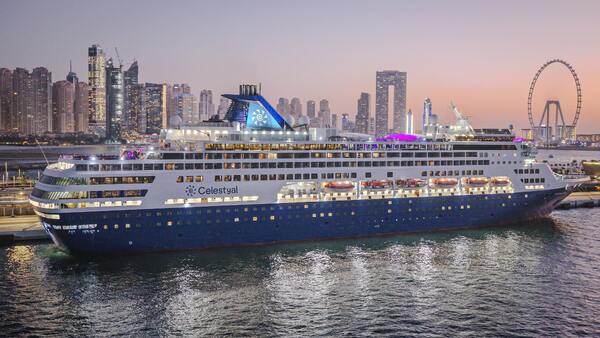Selling Power: making the most of cruise brochures
If you are new to cruise, brochures can be a huge asset. With the wave period approaching, Charlotte Cullinan talks to experienced agencies about how to make the most of them.
Cruise brochures are so important to the team at Myriad Travel that they have their own dedicated home, in a sleek Cruise Lounge.
After moving into new premises in 2015, owner Tiffany Woodley converted the agency’s upstairs floor into an area that racks 85 cruise brochures – nearly half of all the store’s facings – which are divided into luxury, mid-range, budget-friendly lines and river cruises.
“Brochures are highly important for cruise, and are always very well-thumbed by the time customers depart,” Woodley explains.
She often refers to images and dimensions of cabins with customers so they know what to expect, and regularly uses the deck plans.
"They’re fantastic to show customers what will be above and below them and where the lifts are. I find a brochure’s deck plan easier than a computer if there’s more than one customer, plus they can easily take it away once I’ve marked which cabins are available.”
The terms and conditions and FAQs are also popular sections for the Myriad team. “I alway direct customers to those, as it often saves them needing to phone us for questions like whether there’s a hairdryer or bathrobe in their cabin.”
To help the team recall ner details le copies are annotated, with tips such as which cabins to recommend.
All brochures also feature a sticker encouraging customers to “support a local independent business and book with Myriad Travel”, alongside the agency’s contact details.
And customers needn’t worry about juggling multiple brochures, as they are neatly packed into branded hessian bags or cloth bags from cruise lines.
Conversation starters
Stickers are also placed on brochures when the Garstang Travel team restock their shelves. As well as including contact details, each sticker reminds clients that the business was named the UK and Ireland’s best travel agency in TTG’s Top 50 Travel Agencies Awards in 2016.
When the store was refurbished in 2013 the amount of racking space dramatically increased, and now a quarter of the facings are dedicated to cruise – divided into mainstream, luxury and river cruises.
Manager Claire Donnelly says that while all clients enjoy perusing the brochures, they are particularly useful for those who are not sure what cruise they are looking for.
“We tend to bring brochures out at the start of our discussions, and show them info on the ships and deck plans, along with itinerary options.”
Andy Harmer, Clia UK & Ireland director and membership senior vice-president, adds that brochures can also be a key sales tool to help convert holidaymakers from a land-based holiday.
He explains: “They can be a great way to help overcome misconceptions and drill down to specifics. Let the brochures bring the cruise to life.”
Brochures are an additional vehicle for cruise experts to stay abreast of developments in the market, Harmer continues.
“They are useful for the nitty gritty detail, such as types of cabins, variety of restaurants, spa facilities and family amenities.”
Bringing cruise to life
At Tracy Mason Travel, neatly ordered racks housing 90 brochures line the walls of the store, which are always handed out with a business card. Owner Tracy Mason explains: “Customers love brochures, especially for cruises, and they often want them to keep on their coffee tables.”
The agency’s hometown of Penkridge hosts a market twice a week, and to make the most of the extra footfall the team hang branded carrier bags of brochures, lea ets and pens on hooks outside.
A mobile brochure trolley is stationed outside the door, displaying 20 copies of the store’s brochure of the week.
Once customers are inside and Mason has asked initial questions to establish which lines are most suitable, she often uses cruise brochures “like a magazine or book” as part of her sales discussions.
“You’ve got to ensure it’s the right for each customer, and we do use them in a different way to other holiday brochures. We don’t use them to give a price, but to tell people about a line or ship, and they bring it to life in a way that looking online can’t.”
If Mason feels customers are likely to book, she draws on the brochures’ itineraries, cabin descriptions and images of the decks. For those at an earlier stage she often focuses more on the itineraries and then the ships.
Your Holiday Booking homeworker Janet Sprigg agrees that the deck plans and itineraries are key to highlight, and also recommends using brochures to brush up on port details.
“I love using the information on the ports of call, especially ones I’m not familiar with. Itineraries help when clients have certain places they want to visit and it helps you sell when you mention the other lovely ports of call.”
Sprigg keeps several copies of each brochure at home, so that she can hand-deliver them to clients who live nearby, and those who live further a eld receive them by post with a business card and covering letter.
“They get very well read as there is so much information in them and customers tend to want to know everything about their ship and cruise.”
Around a fifth of the 150 brochures in Abbotts Travel are for cruise, which own the prime real estate in the racks nearest the door.
Managing director Julian Abbott explains: “Our regulars have worked out how we rack, but we’ll always ask newcomers how we can help and get involved in a conversation about the type of cruise they’re interested in. For those who just want to take brochures away we’ll always ask for an email address, without being pushy, and give them a card.”
Discussions are also initiated over brochures at Bolsover Cruise Club, but in a slightly different way, as they aren’t displayed in the customer-facing Cruise Centre and Cruise Holiday Shop.
Sales manager Helen Moore explains: “Our clients must ask for them, which provides the starting point for conversations about the product. By having a conversation prior to providing brochures, it helps us to ensure we are matching them with their perfect cruise line and ship.”
Moore says that despite the rise of digital, brochures remain a vital part of the sales process.
“Our demographic still want to hold a hard copy brochure in their hands. With cruise lines varying so much in what they can offer, brochures are a great way of getting that across. A client can compare the brochures of two or three cruise lines and instantly see what sets them apart from each other.”















